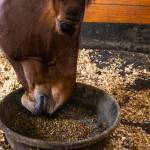Question
I have a Tennesee Walking Horse gelding that is 15 years old. He has not been ridden for three months due to winter. I give him 2 lb (1 kg) of sweet feed twice per day and around 25 to 35 lb (11 to 16 kg) of timothy/orchard hay per day. He is extremely overweight, and I was told he has a hay belly. He has access to pasture 24 hours a day, but in winter there is very little grass. Do I need to stop giving him sweet feed or switch to a different type?
Answer
You don’t mention how much your horse currently weighs, but I would imagine an ideal weight for a typical Tennessee Walking Horse gelding would be 1,000 to 1,200 lb (450 to 550 kg). A horse at maintenance should consume approximately 1.5 to 2% of his body weight per day of forage and concentrate combined. Assuming an ideal weight of 1,100 lb (500 kg), your gelding should consume about 16.5 lb (7 kg) to 22 lb (10 kg) total of forage and concentrate per day. His current ration of 29 to 39 lb (13 to 18 kg) is about twice as much feed as he would need to maintain moderate condition. Reducing your gelding’s weight will increase his well-being by limiting wear and tear on joints and possibly keeping metabolic diseases at bay.
The best way to achieve weight loss is through diet modification and exercise. A first step in trimming your gelding’s girth-line would be to eliminate the sweet feed from his diet. At 4 lb (1.8 kg) per day, your gelding is consuming an excessive amount of calories from that concentrate alone, while possibly getting suboptimal vitamin and mineral fortification. Exchange the sweet feed for a ration balancer, which will supply all of the protein, vitamins, and minerals your gelding requires without excessive calories in a serving of 1 lb (0.45 kg) per day. Perhaps an even better solution is to look into a well-formulated vitamin and mineral supplement, such as Micro-Max (Gold Pellet in Australia). Taking the sweet feed out of the diet should go a long way to helping him lose weight because it will drop the caloric content significantly.
The second step in revising your gelding’s diet involves limiting his forage intake from what he currently consumes to under 22 lb (10 lb) per day, especially if the hay is particularly high-quality. Reduce the amount of hay offered over a period of one or two weeks. If the current hay is high-quality, you might consider locating some hay of middling quality (though not moldy, dusty, or otherwise unhealthy), which will allow him to consume a bit more hay, as there will be less energy in it. Allowing him to nibble on whatever grass is available will help stave off gastrointestinal problems associated with meal feeding, such as gastric ulcers.
In the summer, you might have to outfit your gelding with a grazing muzzle to limit pasture intake or devise a grazing schedule that allows him only partial access to forage.
Changes in diet alone will likely help your gelding lose weight, but you can accelerate the loss somewhat by exercising him regularly. Because he has had the winter off, start off slowly and plan a conditioning program that gradually boosts his condition. Exercise will also help your gelding avoid the onset of metabolic syndrome.








